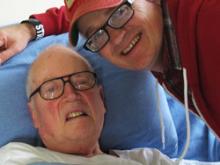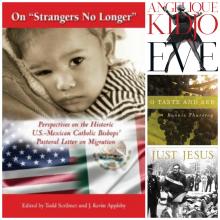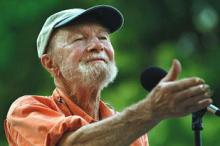inclusivity

CHRISTIAN MYSTICS HAVE a definite dramatic streak. Their transformative encounters with God are full of divine revelations (Julian of Norwich), ecstatic visions (Teresa of Ávila), stigmata (Francis of Assisi), erotic imagery (John of the Cross), and all manner of artistic compositions (here’s to you, Hildegard of Bingen).
But then there’s Brother Lawrence who — if he is known at all — is known for experiencing God’s presence as he washed dishes, cooked eggs, or did other monotonous chores that came with life in a 17th-century French monastery.
Born Nicolas Herman, he emerged from one of Europe’s deadliest religious wars a disabled veteran. Haunted by his past actions and convinced he was eternally condemned, he failed as a hermit (too much time alone with his thoughts), then as a footman (“a clumsy oaf who broke everything,” he recalled), before eventually joining the lay brothers of the Order of the Discalced Carmelites in Paris in 1640. Yet Brother Lawrence’s anxiety persisted. When he tried to pray, he spent the whole time “rejecting thoughts and then tumbling back into these same thoughts.” Eventually, he gave up all his spiritual exercises and focused on becoming aware of God’s presence as he did his assigned work in the monastery’s kitchen. What he experienced wasn’t a celestial vision, but what he had sought all along: God’s peace.
“We go to such great lengths, trying to remain in the presence of God by so many methods,” he told a friend who posthumously published Lawrence’s modest writings and letters. “Isn’t it much shorter and more direct to do everything for the love of God?”
Carmen Acevedo Butcher, an award-winning translator of mystical and classic Christian texts, was drawn to Brother Lawrence’s gentle practice. Acevedo Butcher herself grew up saddled with severe “self-loathing” and anxiety from a childhood shaped by trauma, hellfire preaching, and the strain of being “a brown girl in a white society.” But in Lawrence’s writing she finds someone who experienced real Love amid real pain.
In Practice of the Presence, Acevedo Butcher’s new English translation of Brother Lawrence, she emphasizes his embodied joy and his “original welcoming spirit,” which she sees in his frequent use of tout le monde — “for everybody.” Drawing on Lawrence’s deeply trinitarian theology, Acevedo Butcher uses they/them pronouns for God, a move she hopes will communicate Lawrence’s kind, inclusive understanding of Love to a wide audience. Acevedo Butcher spoke with Sojourners’ Betsy Shirley about translation, mysticism, and how Brother Lawrence’s practice connects to the work of social justice today.

Vote today. Choose the candidates you think represent the best chance to bring God’s values of love, inclusion, justice, healing, and compassion into our world.

The purpose of the episode is not merely to introduce an autistic character, but to show how people with differing abilities can become friends. Sesame Street gently demonstrates the patience and empathy that make up the building blocks of any healthy relationship. It deftly navigates the misimpressions neurotypical children might have when they encounter an autistic person for the first time and shows that a little understanding goes a long way toward making a lifelong friend. When Big Bird first encounters Julia, he mistakes her unresponsiveness to him as a personal dismissal. He must learn that she takes her time answering, particularly when she’s deep in concentration on another activity. While he notices that she does things differently, he soon comes to realize that Julia’s way to play can be a lot of fun.

I see it on nearly every church sign, every church mailing; on the inside fold of every bulletin:
All Are Welcome!
Worship at 9 a.m. Sunday, All Are Welcome!
Potluck Dinner at 5 p.m. Saturday, All Are Welcome!
Vacation Bible School 9 a.m. Monday - Friday, All Are Welcome!
As the pastor of a Lutheran congregation outside Chicago, I find myself tagging it on — almost thoughtlessly — to our invitation cards and mailings as well.
It's almost an auto-signature for churches today: “All Are Welcome!”
And the impulse is a good one. For centuries the church has been exclusive rather than inclusive, despite Jesus' desire to the contrary. We have excluded women, African Americans, immigrants, gays and lesbians, people with special needs, senior citizens, singles, 20-somethings — at times the church has been downright discriminatory.
A friend of mine once told me he was desperate to find a church where he could not only worship but perhaps join the choir and get involved with music ministry. He brought his friend, another professional musician, to check out area churches. They found one they liked and were surprised when the minister asked them into his office. Ascertaining that they were both, indeed, gay, the minister said: "Well, you can attend. But just sit in the back row."
Thanks be to God, my friend didn't give up his search or lose his faith. He has since found an affirming congregation and leads incredible music there.
But too many of us have these stories: The congregation that saw single folks as irrelevant. The congregation that scorned Spanish-speaking immigrants. The place that found people with special needs disruptive.
Fortunately, many churches became aware of the way they had been contradicting the primary, freeing message of the Gospel: that all may be one in Christ Jesus, and that there is no longer Gentile or Jew, man or woman, black or white, slave or free, gay or straight, rich or poor ... (from Galatians 3:28).
As a needed corrective to become inclusive rather than exclusive, churches have hit upon a simple formula. It goes something like this: "Let's add ‘ALL ARE WELCOME’ to everything we publish. Let's make WELCOME the center of what we do."

For the better part of the last 30 years, my father has been a social justice activist serving as a leader within his Christian denomination, most specifically in various leadership roles where he could be an advocate for anti-racism education, universal health care, peace with justice in the middle East, and for full inclusion of our LGBTQ family within the body of Christ.
His activism actually dates back further, to the early 1960s when he marched with Dr. Martin Luther King, Jr. in Selma, Ala. His work in the 1990s and 2000s reflected a great depth of thought and commitment as he educated himself and others like him about the importance of recognition of the role of white heterosexual privilege in society and the need for collective repentance for ignoring structural sin regarding race, gender, class, and sexual preference. He worked to transform institutions that might inhibit the full expression of personhood for all of God’s children.

It is easy to see that over the coming weeks thousands of evangelicals will withdraw their support from World Vision. And Dr. Moore is absolutely right. As this begins to take place, thousands of children will suffer because of the lack of funding from their former sponsors who decided that this theological and political issue was more important than their life. It is a sad day when followers of Jesus Christ will chose to make a theological/political point by withholding funds from children in life-and-death situations.
It is indeed a sad day for evangelicalism. It is sad because we have willingly put on blinders to hide our eyes from the truth of the words of our Lord Jesus Christ. We have chosen to ignore the entire example of his life and the bulk of his teachings and instead pick up our weapons and engage in culture wars instead of working to love God and love our neighbors as ourselves, which, by the way, sums up all of the biblical laws. We have chosen to ignore Jesus’ harsh words to the Pharisees who valued doctrinal rightness over the sacrifice of justice that God has always called us to.

The Spirit’s Work
Just Jesus: My Struggle to Become Human, by Walter Wink with Steven Berry, is the final book by the late, influential Christian thinker. It blends brief autobiographical vignettes with essays on key themes in Wink’s work, offering insights into how his life story shaped his faith, thought, and witness. Image
Border Truths
On “Strangers No Longer”: Perspectives on the Historic U.S.-Mexican Catholic Bishops’ Pastoral Letter on Migration is a collection of essays by scholars and policy experts that uses the 2003 pastoral letter on immigration “Strangers No Longer: Together on the Journey of Hope” as its starting point. Paulist Press

WHEN I MOVED out of my Sojourners magazine office in 1988, I took with me two signed review copies of books. One was Roll the Union On: A Pictorial History of the Southern Tenant Farmers’ Union. It was inscribed to me personally by H.L. Mitchell, a founder of the STFU, so I felt entitled to keep it.
The other book bore no inscription, just a simple black ink signature above the Simon & Schuster logo. It was called Carry It On! A History in Song and Picture of America’s Working Men and Women, and the co-author who signed it was Pete Seeger. I’m looking at that signature now, as I write this on the day Seeger died.
I told myself that I kept that book because I thought it might come in handy. After all, it had 11 translations of “L’Internationale” and all the words to “Solidarity Forever.” But really I kept it for the signature. I liked the idea of having something that I knew had come from the hand of someone who had ridden the rails with Woody Guthrie. Seeger was our living connection to the culture of the 1930s when, for a moment, radical dreams about a country owned and operated by its ordinary citizens seemed almost ready for prime time.
Of course, that moment passed, and those dreams were shattered by the Red Scare and the Cold War that followed. But Seeger came out on the other side with his integrity and ideals intact. Despite being honored by the last two Democratic presidents, he never renounced his radical vision of what America could be. Seeger left the Communist Party in the early 1950s and frankly acknowledged that he should have done so sooner, but he never stopped calling himself a “small c” communist. In 1994, he told The Washington Post, “Our ancestors were all socialists: You killed a deer and maybe you got the best cut, but you wouldn’t let it rot, you shared it.” Still, he was a pragmatic radical, who added that socialists should recognize that “every society has a post office and none of them is efficient. No post office anywhere invented Federal Express.”
WHEN I MOVED out of my Sojourners magazine office in 1988, I took with me two signed review copies of books. One was Roll the Union On: A Pictorial History of the Southern Tenant Farmers’ Union. It was inscribed to me personally by H.L. Mitchell, a founder of the STFU, so I felt entitled to keep it.
The other book bore no inscription, just a simple black ink signature above the Simon & Schuster logo. It was called Carry It On! A History in Song and Picture of America’s Working Men and Women, and the co-author who signed it was Pete Seeger. I’m looking at that signature now, as I write this on the day Seeger died.
I told myself that I kept that book because I thought it might come in handy. After all, it had 11 translations of “L’Internationale” and all the words to “Solidarity Forever.” But really I kept it for the signature. I liked the idea of having something that I knew had come from the hand of someone who had ridden the rails with Woody Guthrie. Seeger was our living connection to the culture of the 1930s when, for a moment, radical dreams about a country owned and operated by its ordinary citizens seemed almost ready for prime time.
Of course, that moment passed, and those dreams were shattered by the Red Scare and the Cold War that followed. But Seeger came out on the other side with his integrity and ideals intact. Despite being honored by the last two Democratic presidents, he never renounced his radical vision of what America could be. Seeger left the Communist Party in the early 1950s and frankly acknowledged that he should have done so sooner, but he never stopped calling himself a “small c” communist. In 1994, he told The Washington Post, “Our ancestors were all socialists: You killed a deer and maybe you got the best cut, but you wouldn’t let it rot, you shared it.” Still, he was a pragmatic radical, who added that socialists should recognize that “every society has a post office and none of them is efficient. No post office anywhere invented Federal Express.”

ONE RECENT WINTER day, Nora Howell stepped out of her house in the Sandtown neighborhood of Baltimore and took a walk down the street. People in the predominantly black community did double takes as this white woman promenaded past them in a sundress made of saltine and oyster crackers. Some stared in disbelief. One man doubled over laughing. In the corner coffee shop, one of the regulars warned Howell not to walk by any homeless people because they might just eat her up.
Later Howell, a community artist and director of the neighborhood Jubilee Arts program, set the video footage taken during her walk to Mister Rogers’ classic refrain, “Won’t You Be My Neighbor?” The piece, which emerged out of Howell’s ponderings on what it means to be white living in a black neighborhood, became another part of her answer to a call: to use art to address systemic racism and bring about the kingdom of God.
From Race Riots to White Suburbia and Beyond
In 2001, Howell was an eighth grader living in a biracial community in urban Cincinnati. When race riots erupted after a young black man was shot fatally by a white police officer (sound familiar?), her family took to the streets on a prayer walk through the riots. Howell remembers being shocked and terrified, thinking, “Why do we still have race riots? Cincinnati is so far behind the times.”
In the aftermath, Howell talked with peers at school on the reality of racial tensions and observed with curiosity how white and black churches throughout the city responded. She realized race riots weren’t just a relic of the ’60s. “When you lived in a place where different racial groups interacted daily, [racial tensions] could no longer be denied or ignored,” she said.
Yet when Howell moved to suburban Chicago to attend Wheaton College, conversations on race were largely absent. “I found that very odd,” she said. She got involved in a campus group to promote awareness of racial injustice.
JUANA TOBAR SAYS she is waiting for a miracle from God. She’s the mother of four wonderful children and a grandmother of two young girls. Her husband, Carlos, a U.S. citizen, calls her the “glue of their family” and his soul mate. Juana has lived in North Carolina for more than 20 years and serves as an usher in her church, but in the coming weeks the Obama administration will be deciding whether or not to deport her back to Guatemala.
Juana’s case is not unusual. According to its own statistics, Immigration and Customs Enforcement (ICE) has deported approximately 400,000 immigrants per year since President Obama took office in 2009. In March, he’s set to reach the dubious marker of 2 million deportations, more than any other president. Many of us who work with immigrant communities are left asking: Why would a president—especially one who enthusiastically supports immigration reform that would give the undocumented a chance to stay in the country and earn citizenship—so aggressively deport the same immigrants who could be legalized through reform?
Our best guess is that when Obama entered office, his administration made a calculation that if they showed they were serious about enforcement, lawmakers would be more likely to come to the table and negotiate. That goodwill never materialized. Now, five years later, ICE is feeling increasing heat from immigrant advocates.
One of the key discrepancies between ICE and its critics is the question of who is being deported. In 2011, the administration issued a memo vowing to focus deportations on “convicted criminals,” a scary label until you realize how DHS defines the term. Immigrants commit crimes at much lower rates than the native born, so there are only so many serious criminals to find and deport. Thus, ICE has come to define “criminal” loosely, covering both violent felons and people who get a traffic ticket. A substantial number of those who are deported don’t count as “criminals” even under that definition. And many are the parents of U.S. citizens. In the first six months of 2011, for example, ICE deported nearly 50,000 parents of U.S. citizens—people like Juana Tobar.
MOST MEDIA ACCOUNTS of Nadia Bolz-Weber focus on her tattoos. She has the liturgical year tattooed on one arm, from creation to Pentecost; another features Lazarus still wrapped, but very much alive. She got that one while struggling to write a sermon on Jesus’ raised friend.
The tattoos on a 6’1” woman with a taste for punk, a bad-girl past, and a gay-inclusive church—House for All Sinners and Saints in Denver—make for easy picking for secular media. You may have caught Bolz-Weber’s book Pastrix on the New York Times bestseller list. Wise, self-aware, hipster Christian celebrities have a market for books, and she’s tapped it.
In contrast to much of the superficial media coverage, what’s most interesting about Bolz-Weber is her deep traditionalism. “Secular media doesn’t understand the difference between orthodox and conservative,” she tells me through a toothy smile, blue-green eyes blazing over thick-rimmed ’50s-era glasses.
“House,” as the community calls itself, is almost medieval in its liturgy. There are no instruments, just a cappella chant and pillows for kneelers at a prayer station. The Eucharist is served weekly. Eastern Orthodox iconography drapes the church’s interior, stoles, website, and literature. Latin hymns fill the communion liturgy on the Sunday evening I attend. Bolz-Weber is proud to be using Franz Schubert’s setting for the Mass.
This is not high church fussiness; it is liturgical and churchly orthodoxy for scruffy hipsters. Bolz-Weber explains that many of her fellow social progressives want to jettison the Bible and Jesus in order to be more inclusive. “But why should we jettison the only things we have going for us?” she asks.

JOY CARROLL and I were married in 1997. A year later, we had our first son, Luke. We met at a delightful British festival of faith, the arts, and justice called Greenbelt. Joy—a Brit—was on the Greenbelt board and also one of the speakers, as was I. We were on a panel together in a tent with a couple thousand young people, and that’s where our relationship began. I had coffee with Joy afterward, and she told me about the long journey women had made toward ordination in the Church of England.
Joy had been trained as a priest at Durham, just the same as the men, but at that time wasn’t able to be ordained to the priesthood. Her first parish was in a housing estate (what we would call a housing project) in the middle of an impoverished neighborhood with lots of drugs and violence—a place where male priests were afraid to take their families. As a deacon, Joy moved in to live and work in the housing estate, doing everything a priest would do except celebrate the Eucharist, which was still reserved for males only. At age 29, she was elected to the church’s General Synod—its youngest member—and in November 1992 she cast a vote for women’s ordination. Joy went on to become one of the first women ordained as a priest in the Church of England.
When Luke was 4 years old, we found ourselves back at Greenbelt, again as speakers. Sunday morning is always a high point at the Greenbelt festival, with creative and powerful worship that draws most of the 20,000 in attendance. Joy was on the main stage as the chief celebrant of the Eucharist, while Luke cuddled on my lap, carefully watching his mother at the altar. He looked up at me and asked, “Dad, can men do that too?”
WHEN CECIL WILLIAMS was 8 years old, he imagined murdering a police officer. It’s a jarring way for an influential minister to begin a memoir about radical hope and perseverance. But in a short lifetime of intense oppression, Williams had already internalized heartbreaking lessons of systemic injustice and the righteously violent tendencies that can follow. The budding young leader already nicknamed “Rev” and wise beyond his years also knew that if he could imagine brutality, he could envision a transformed society.
“Imagination is one of the most penetrating and incendiary forces I’ve ever experienced,” he writes in Beyond the Possible: 50 Years of Creating Radical Change at a Community Called Glide, co-authored with his wife and longtime collaborator, Janice Mirikitani. Building on their shared vision over a remarkable half-century, they lead what might be the most exuberant congregation in America. Glide Memorial United Methodist Church and the Glide Foundation are inextricable, legendary San Francisco institutions, the latter one of the city’s largest social service providers and the real-life shelter featured in the 2006 biopic The Pursuit of Happyness.
Writer Dave Eggers sums up Glide in the book’s introduction with a simple but uncomfortable truth: There are very few places in society where someone is not left out. Houses of worship are supposed to make a dream of inclusivity possible, but even the most inspiring visionaries live and lead imperfectly. Eggers proposes that because of the unconditional love necessary for a lasting marriage between two seemingly incompatible leaders—Williams, a black Texas minister with a solid upbringing, and Mirikitani, an agnostic Japanese-American poet from a broken, abusive home—Glide is one of the few radically accepting places where true unconditional love is practiced like the most dogmatic of faiths.

AS THE SEAONS after Pentecost unfolds, we might think that summer calls for a kind of “church lite” in which we shouldn’t expect much to happen. With the dramatic commemorations behind us, the scriptures seem miscellaneous. But this season has its own purpose of soaking in the Word. Just let go of dependence on drama.
Our month’s reading opens in 2 Kings 5 with the healing of Naaman, the distinguished Aramean general, told with a dry humor that Jesus appreciated, since he specifically mentions it (Luke 4:27) in his teaching about faith found outside the bounds of Israel. At first Naaman’s dignity is offended by Elisha not bothering even to meet him in person. His pride receives a further blow in the ludicrous banality of the prescription that Elisha’s assistant passes on: “Go, and wash in the Jordan seven times” (verse 10). Naaman’s fuming about the short shrift he got, and the humiliation of being prescribed a business of splashing in a local stream, are quite comic. Paddling in the Jordan indeed—a ditch in comparison to the storied rivers of Damascus! Smiling, we recognize the storyteller’s shrewd knowledge of psychology. The tale has a good ending. Finally getting off his high horse, Naaman allows his aide to persuade him to try the simple bathing routine. Over time his skin is healed and rejuvenated.
The church behaves like that shrewd aide when it invites us to trust in the power of hearing the scriptures again and again, however overfamiliar some of them seem, and others obscure.